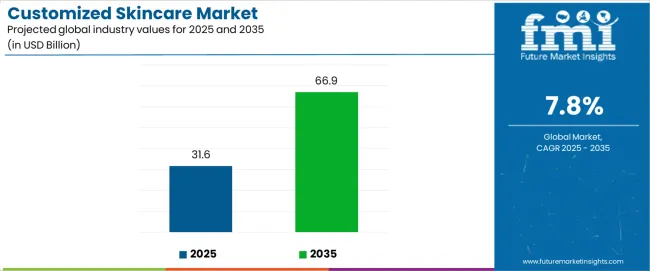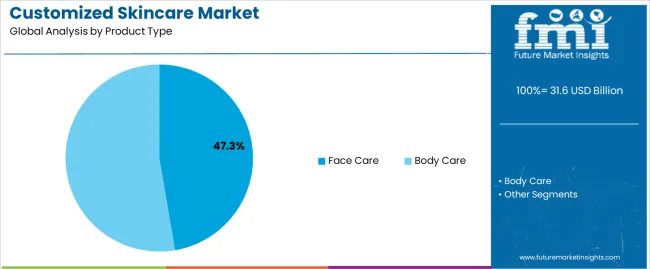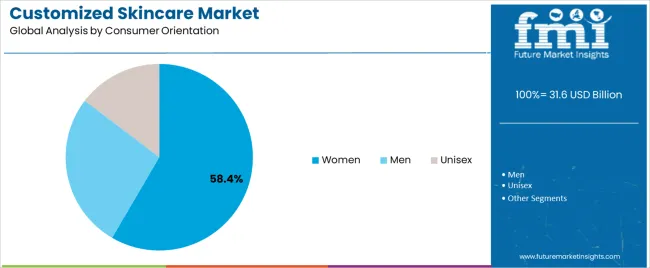The customized skincare market is experiencing robust growth driven by increasing consumer preference for personalized beauty solutions, advancements in skin analysis technologies, and rising awareness of ingredient efficacy. Current market conditions are influenced by the shift from generic skincare products to individualized formulations tailored to specific skin concerns and lifestyles. Digital platforms and AI-powered diagnostic tools are enabling brands to offer data-driven customization, enhancing consumer trust and engagement.
The future outlook is strengthened by ongoing innovation in biotechnology, formulation science, and product delivery systems. Expansion across e-commerce and direct-to-consumer channels is further accelerating adoption. Growth rationale is built on rising disposable incomes, heightened focus on self-care, and the demand for high-performance skincare regimens that deliver measurable results.
Manufacturers are investing in sustainable sourcing, transparency, and dermatological validation to strengthen brand credibility These combined factors are expected to maintain long-term growth momentum and reinforce customized skincare as a key segment within the global beauty industry.


| Metric | Value |
|---|---|
| Customized Skincare Market Estimated Value in (2025 E) | USD 31.6 billion |
| Customized Skincare Market Forecast Value in (2035 F) | USD 66.9 billion |
| Forecast CAGR (2025 to 2035) | 7.8% |
The market is segmented by Product Type, Skin Type, Consumer Orientation, and Distribution Channel and region. By Product Type, the market is divided into Face Care and Body Care. In terms of Skin Type, the market is classified into Combination Skin, Dry Skin, Oily Skin, and Normal Skin. Based on Consumer Orientation, the market is segmented into Women, Men, and Unisex. By Distribution Channel, the market is divided into Online Retailers, Modern Trade, Departmental Stores, Convenience Stores, Specialty Stores, Mono Brand Store, and Other Sales Channel. Regionally, the market is classified into North America, Latin America, Western Europe, Eastern Europe, Balkan & Baltic Countries, Russia & Belarus, Central Asia, East Asia, South Asia & Pacific, and the Middle East & Africa.

The face care segment, holding 47.30% of the product type category, has emerged as the dominant segment due to its extensive adoption in daily skincare routines and its adaptability to personalized formulations. Consumer demand has been sustained by growing interest in targeted treatments such as serums, moisturizers, and masks designed for individual skin profiles.
Innovation in active ingredient combinations and digital skin assessment tools has elevated customization accuracy, enhancing user satisfaction and product performance. Manufacturers are focusing on integrating dermatologically tested and data-backed solutions, which has increased consumer confidence.
The segment’s leadership is expected to continue as technological integration, premiumization, and subscription-based skincare models further strengthen its market position.

The combination skin segment, representing 36.80% of the skin type category, has maintained its leading position due to the widespread prevalence of mixed skin characteristics and the need for balanced formulations. Personalized solutions addressing both oil control and hydration have driven sustained consumer engagement.
Brands have been leveraging AI-driven diagnostics and machine learning algorithms to analyze individual skin zones and create adaptive product blends. The segment benefits from rising awareness of skin microbiome balance and ingredient sensitivity management.
Continued advancements in product texturization and formulation science are expected to optimize efficacy, reinforcing combination skin solutions as a major revenue driver in the customized skincare industry.

The women segment, accounting for 58.40% of the consumer orientation category, has remained the largest contributor owing to strong purchasing power, brand engagement, and willingness to invest in premium skincare. Increased awareness of self-care and holistic beauty regimens has reinforced adoption across diverse age groups.
Marketing strategies emphasizing personalized experiences and inclusivity have strengthened brand loyalty. Women consumers are increasingly favoring evidence-based products that align with dermatological recommendations and clean beauty standards.
The segment’s leadership is projected to persist as digital customization platforms, tailored marketing campaigns, and targeted product innovation continue to expand accessibility and enhance user experience in the personalized skincare landscape.
From 2020 to 2025, the customized skincare market experienced a CAGR of 5.2%. The advent of technology, particularly AI and machine learning, revolutionized the customized skincare market by enabling brands to analyze vast amounts of consumer data and deliver personalized recommendations at scale.
Virtual consultations, skin analysis tools, and mobile apps became popular ways for consumers to receive customized skincare advice from the comfort of their homes.
As awareness of customized skincare grew, so did the number of brands entering the market. Established beauty companies began to offer personalized options within their product lines, while start-ups and pure-play customization brands emerged to cater to the growing demand.
Collaboration between skincare brands, technology companies, and industry experts will drive innovation in the customized skincare market. New product formulations, delivery systems, and customization options will continue to emerge to meet evolving consumer needs. Projections indicate that the global customized skin care market is expected to experience a CAGR of 7.8% from 2025 to 2035.
| Historical CAGR from 2020 to 2025 | 5.2% |
|---|---|
| Forecast CAGR from 2025 to 2035 | 7.8% |
The provided table highlights the top five countries in terms of revenue, with China and India leading the list. Social media platforms and beauty influencers play a significant role in shaping consumer preferences and driving demand for customized skincare products in China.
The demand for customized skincare in India is expected to continue growing as consumers increasingly prioritize personalized solutions that cater to their unique skincare needs and preferences.
| Countries | Forecast CAGRs from 2025 to 2035 |
|---|---|
| The United States | 4.5% |
| The United Kingdom | 4.9% |
| China | 8.9% |
| India | 10.7% |
| Australia | 8.2% |

The customized skincare market in the United States is expected to expand with a CAGR of 4.5% from 2025 to 2035. Consumers in the United States are increasingly seeking skincare products tailored to their individual needs and preferences.
This trend is driven by factors such as the desire for more effective solutions, the rise of self-care practices, and growing awareness of the importance of skincare.
The integration of technology, such as artificial intelligence and machine learning, has revolutionized the customized skincare market. Brands leverage data analytics and algorithms to analyze individual skin concerns and provide personalized product recommendations, enhancing the consumer experience.
Endorsements from celebrities and influencers play a significant role in promoting customized skincare products to consumers in the United States. Influencer marketing campaigns and social media endorsements help raise awareness and drive demand for personalized skincare solutions.
The customized skincare market in the United Kingdom is expected to expand with a CAGR of 4.9% from 2025 to 2035. The growth of e-commerce platforms has made it easier for consumers in the United Kingdom to access customized skincare products from anywhere. Online shopping offers convenience, a wide selection of products, and access to virtual consultations and skin analysis tools, contributing to market growth.
The customized skincare market in the United Kingdom is poised for continued growth as consumers increasingly prioritize personalized solutions that cater to their unique skincare needs and preferences. Brands that leverage technology, transparency, and direct-to-consumer strategies are likely to thrive in this evolving market landscape.
The customized skincare market in China is expected to expand with a CAGR of 8.9% from 2025 to 2035. With increasing disposable income, Chinese consumers are willing to invest more in premium skincare products that offer personalized solutions tailored to their specific needs and preferences.
There is a growing emphasis on beauty and skincare in Chinese culture, with consumers prioritizing skincare as part of their self-care routines. Customized skincare allows individuals to address their unique skin concerns and achieve their desired skincare goals.
Online shopping offers convenience, a diverse selection of products, and access to virtual consultations, contributing to the growth of the customized skincare market in China.
The rising middle class and increasing disposable income have led to greater spending on personal care products, including skincare, driving the growth of customized skincare in India. The customized skincare market in India is expected to expand with a CAGR of 10.7% from 2025 to 2035.
There is a growing emphasis on beauty and skincare in Indian society, driven by factors such as media influence, urbanization, and exposure to global beauty trends. Consumers are increasingly prioritizing skincare as part of their self-care routines, leading to a greater demand for customized solutions.
The customized skincare market in Australia is expected to expand with a CAGR of 8.2% from 2025 to 2035. Australians are increasingly prioritizing health and wellness, including skincare, as part of their lifestyle.
Consumers are becoming more aware of the importance of skincare in maintaining healthy and radiant skin, leading to a growing demand for personalized solutions.
Australia's diverse climate, with harsh sun exposure and varying environmental conditions, poses unique challenges for skincare. Customized skincare allows individuals to address specific concerns such as sun damage, dehydration, and pollution exposure, catering to the needs of Australian consumers.
The below section shows the leading segment. The face care segment is to account for a market share of 64.1% in 2025. Based on consumer orientation, the female segment is expected to have a share of 59.2%.
| Category | Market Share |
|---|---|
| Face Care | 64.1% |
| Female | 59.2% |
The face care segment emerged as the dominant force in the customized skincare market, commanding 64.1% of the total market share in 2025. Every individual has unique skin concerns, such as acne, dryness, aging, sensitivity, or hyperpigmentation. Customized skincare allows consumers to address these specific concerns with tailored solutions rather than relying on one-size-fits-all products.
Consumers have different preferences when it comes to skincare products, including texture, scent, and ingredients. Customization allows individuals to choose products that align with their preferences, leading to higher satisfaction and adherence to skincare routines.
The high demand for face care products in the customized skincare market is driven by the desire for personalized solutions that address individual needs, preferences, and concerns effectively. As technology advances and consumer awareness continues to grow, the popularity of customized skincare is expected to increase further.
Female Segment to account for a market share of 59.2% in 2025. The demand for customized skincare among females is driven by the desire for personalized solutions, efficacy, empowerment, technological advancements, ingredient transparency, and the influence of marketing and influencers.
As women continue to prioritize skincare as part of their self-care routines, the demand for customized skincare is likely to remain high.
FCustomized skincare empowers women to take control of their skincare routines and make informed decisions about the products they use. By selecting ingredients and formulations that align with their preferences and values, women feel more confident and in charge of their skincare journey.
Many women prioritize ingredient transparency and prefer products with clean, non-toxic formulations. Customized skincare brands often offer transparency regarding ingredient sourcing and avoid potentially harmful substances, appealing to health-conscious consumers.

Leading players invest in cutting-edge technology such as AI, machine learning, and data analytics to gather extensive consumer data and provide personalized skincare recommendations. Market players enhance their credibility and reach new audiences through collaborations with influencers, dermatologists, and other industry experts.
| Attributes | Details |
|---|---|
| Estimated Market Size in 2025 | USD 31.6 billion |
| Projected Market Valuation in 2035 | USD 66.9 billion |
| Value-based CAGR 2025 to 2035 | 7.8% |
| Forecast Period | 2025 to 2035 |
| Historical Data Available for | 2020 to 2025 |
| Market Analysis | Value in USD billion |
| Key Regions Covered | North America; Latin America; Western Europe; Eastern Europe; South Asia and Pacific; East Asia; Middle East and Africa |
| Key Market Segments Covered | Product Type, Skin Type, Consumer Orientation, Distribution Channel, Region |
| Key Countries Profiled | The United States, Canada, Brazil, Mexico, Germany, The United Kingdom, France, Spain, Italy, Russia, Poland, Czech Republic, Romania, India, Bangladesh, Australia, New Zealand, China, Japan, South Korea, GCC countries, South Africa, Israel |
| Key Companies Profiled | Bare Anatomy; Clinique Laboratories, LLC; DermaCare; FitSkin Inc; Function of Beauty; Glory Skincare; L’Oréal; My Beauty Matches; Neutrogena; Sequential Skin |
The global customized skincare market is estimated to be valued at USD 31.6 billion in 2025.
The market size for the customized skincare market is projected to reach USD 66.9 billion by 2035.
The customized skincare market is expected to grow at a 7.8% CAGR between 2025 and 2035.
The key product types in customized skincare market are face care, _cleansers and exfoliators, _serums and treatments, _moisturizers, _others and body care.
In terms of skin type, combination skin segment to command 36.8% share in the customized skincare market in 2025.






Full Research Suite comprises of:
Market outlook & trends analysis
Interviews & case studies
Strategic recommendations
Vendor profiles & capabilities analysis
5-year forecasts
8 regions and 60+ country-level data splits
Market segment data splits
12 months of continuous data updates
DELIVERED AS:
PDF EXCEL ONLINE
Customized Premix Market Analysis - Size, Share, & Forecast Outlook 2025 to 2035
Customized Avionic Systems Market Growth - Trends & Forecast 2025 to 2035
Customized Holiday Market Analysis – Trends & Forecast 2024-2034
Customized Hair Care Market Trends – Growth & Forecast 2024-2034
Korea Customized Premix Market Analysis – Size, Share & Trends 2025 to 2035
Demand for Customized Premix in EU Size and Share Forecast Outlook 2025 to 2035
Western Europe Customized Premix Market Analysis – Size, Share & Trends 2025 to 2035
Demand and Trend Analysis of Customized Premix in Japan Size and Share Forecast Outlook 2025 to 2035
Skincare Supplement Market Size and Share Forecast Outlook 2025 to 2035
Skincare Oil Market Size and Share Forecast Outlook 2025 to 2035
Skincare Nutritional Serum Market Size and Share Forecast Outlook 2025 to 2035
Skincare Products Market Size and Share Forecast Outlook 2025 to 2035
Skincare Market Analysis - Size, Share, and Forecast Outlook 2025 to 2035
Skincare Packaging Market Size, Share & Forecast 2025 to 2035
Skincare Industry in India – Trends & Growth Forecast 2024-2034
Global Skincare Treatment Market Analysis – Size, Share & Forecast 2024-2034
Global PDRN Skincare Market Size and Share Forecast Outlook 2025 to 2035
Men’s Skincare Products Market Size, Growth, and Forecast for 2025 to 2035
Global Smart Skincare Market Size and Share Forecast Outlook 2025 to 2035
Cooling Skincare Gels Market Size and Share Forecast Outlook 2025 to 2035

Thank you!
You will receive an email from our Business Development Manager. Please be sure to check your SPAM/JUNK folder too.
Chat With
MaRIA